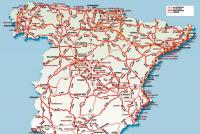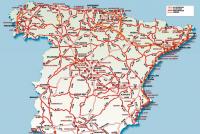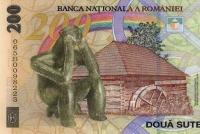Essay: Competition Her place and role in modern market economy. Market competition in the modern economy Competition in the economy Society











 Back forward
Back forward
Attention! Preview slides is used exclusively for informational purposes and may not provide ideas about all presentation capabilities. If you are interested this workPlease download the full version.
Class: 10
Equipment:interactive board (screen), teacher's computer, Microsoft Office PowerPoint 2003, presentation, scales with two bowls, paper weights.
Objectives lesson:
- educational: Identify the economic importance of competition, characterize the types of competition, to identify the advantages and disadvantages of competition;
- developing: develop the ability to think independently, logic, apply the previously studied material for the assimilation of the new material;
- raising: Rail in students the ability to independently receive knowledge, responsibility, attention.
During the classes
1. Organizational stage
Teacher: "Hello. Today, we must learn quite bulk material, so I ask everyone to tune in to intensive work. " (A working sheet is heard in advance to each student; on the slide №1 board).
2. Actualization of knowledge
Teacher: "The modern market economy is a complex organism consisting of a huge number of various production, commercial, financial and information structures interacting against the background of an extensive system of legal norms of business, and united by a single concept - the market. Today in the lesson we will analyze the key concept expressing the essence of market relations. Your task, after listening to the parable of the famous book "Quadrant of cash flow" Robert Kiyosaki to determine the subject of the lesson. " (Next, the teacher tells the parable)
3. Studying a new material
Teacher: "So, what economic concept is described in this situation ( students: “rivalry") and the topic of our lesson: (Pupils: "Competition").There are many statements about this concept, for example: Evin Cannan believes that "economic competition is not a war, but rivalry in the interests of each other. This is an incentive for business development. " But Anthony de Mello in the collection "one minute of nonsense" wrote that the competition is the source of the universal evil, she reveals the worst thing in you, for he teaches hate. How many people, so many opinions. Tell me, in order to agree with them or refute what we need to do in class (students: "identify the economic importance of competition, determine the advantages and shortcomings of competition"). To do this, consider the following questions in the lesson: 1) Competition: Definitions and functions; 2) Types of Competition; 3) advantages and disadvantages of competition. Go to the consideration of the first question. With this concept, we have already met, studying the types of economic systems. Therefore, try to define the concept of "competition", relying on previously gained knowledge. (Students offer their own options, then the material is generalized by the teacher). Competition - (from Lat. Concurrere - Faced) - Fighting independent economic entities for limited economic resources. A. Smith interpreted competition as a behavioral category, when individual sellers and buyers compete on the market for better sales and purchases, respectively. Competition performs the following functions in the economy: regulation, motivation, distribution, control (students are proposed to relate the name of the function with a description of reality, slide 7) The results of any company are highly dependent on its costs, but also on the type of competition with which it is necessary to deal with your products. Those. We go to the second question: types of competition. Your task in the course of identifying the main types of competition and make their distinctive features in the table (see Appendix) you will learn to check at the end of the lesson. "
A teacher on the board shows an example of the type of competition, and students independently, according to the criteria, determine the main signs. The table is checked (students call their own options).
Teacher: "To secure this material, I suggest you work with the following exercise, your task read carefully and answer questions, arguing your answer (see Appendix).
After fixing the material on the second issue, students are invited to vote "for" or "against" approval: "Competition is a business incentive." Each student puts a paper gircuit on the scales "for" or "against" competition, arguing his answer.
Answers can be as follows:
Benefits:.
1. Promotes more efficient use of resources;
2. Causes the need to respond flexibly and quickly adapt to changing production conditions;
3. Creates conditions for the optimal use of scientific and technical achievements in the field of creating new types of goods, etc.;
4. Provides freedom of choice and actions of consumers and manufacturers;
5. Seals manufacturers to meet the diverse needs of consumers and improve the quality of goods and services.
Disadvantages:
1. It does not contribute to the preservation of non-reproducible resources (animals, minerals, forests, water, etc.);
2. Negatively affects environmental ecology;
3. It does not ensure the development of production of goods and services of public use (roads, public transport, etc.);
4. Does not create conditions for the development of fundamental science, education systems, many elements of urban economy;
5. Does not guarantee the rights to work (stimulates unemployment), income, rest;
6. Does not contain mechanisms that impede the emergence of social injustice and stratification of society on rich and poor.
4. Fastening the material studied
Students are invited to perform a test (see Appendix)
Summing up the lesson
Each of you have already received an assessment for the test, they saw how they were traded by new material, but I would like to show the following questions at the end of the lesson:
- What economic term was about this lesson?
- What purpose was put before us? Have we reached her?
- What did you like (did not like) in the lesson?
- Can you rate your work at the lesson? (It is proposed to fill the estimated sheet, see appendix)
Homework:paragraph 7.1 (basics economic theory / Ed. S.I. Ivanova); Create examples of industry markets of the Ramensky district for each type of competition.
The essence of competition is constantly searching best conditionsfor both the consumer and the seller.
For all participants market relations Competition is a phenomenon of an objective and forced nature, but, first of all, it is for the manufacturers of goods and services. The realities of competitive struggle make enterprises introduce new production technologies, improve labor productivity, hold or reduce product costs. In other words, competition contributes to a decrease in production costs, saving resources, causes the most efficiently combined production factors used as rationally.
In a healthy market competition, the activities of any economic entity are susceptible to dual control - internal and external. Mediated external control from competitors cruel and impartial. The competitiveness of the enterprise, ultimately, gives a consumer assessment, giving her preference to goods, services of a particular participant in the competitive struggle.
In economic theory, there is no one definition of the concept of competition.
Classical political economy determines competition as a rivalry for the sake of profit. Also in economic literature, the relationship of enterprises in the context of the comparison of the results of their economic activity is also called.
Competition is a challenging, multivalued and multifunctional category. It provides normal development, self-regulation and market functioning.
Competition functions
Competition B. market economy Performs the following functions:
- Regulation. For victory in a competitive struggle, the manufacturer must offer the goods and services that are prioritized by the Buyer. Production factors under the influence of the price are redistributed in the industry, they are most in need.
- Motivation. Commodity producers offering quality products at the best price, that is, made with the smallest costs, make a profit, which becomes an incentive for technical progress. Enterprises that do not respond to the needs of consumers who violate the rules of competitive rivalry are losses and can be fully ousted from the market.
- Distribution. Competitive struggle not only stimulates improving productivity, but also contributes to the equitable distribution of income between its participants, depending on the effective contribution of each.
- The control. Thanks to competition economic influence Each business entity is limited. The buyer can choose among several sellers. And if we are talking about the price of a product or service, then the cleaner (perfect) market competition, the fair the final price for the consumer.
Classification
Competition is classified by different features.
In scale of development
- individual (between specific market participants);
- local (on a certain territory);
- sectoral (within the framework of one industry);
- inter-sectoral (between different sectors of the market);
- national (within one country);
- global (world market).
By the nature of development
- price (manifests itself with artificial decline in prices for services or goods);
- intense (lies in improving the quality of the product, modernization of production technologies, introducing innovation and manifests itself in attempts to produce fundamentally new product or improve existing).
Depending on the prerequisites for competitive balance on the market
- perfect (based on the implementation of the prerequisites of the competitive balance and implies the presence of a large number of independent producers and buyers);
- imperfect (based on a violation of the prerequisites of the competitive balance and implies the division of the market between several manufacturers (oligopoly) or a complete monopoly).
Depending on the needs that one or another product satisfies
- horizontal (rivalry between manufacturers of identical goods);
- vertical (struggle between manufacturers of various products that satisfy the same needs).
Competition in the economy is a complex and multifaceted concept. It performs many features: contributes to the self-regulation of the market, improving the quality of goods and services, a decrease in production costs, creating better conditions, both for manufacturers and consumers of goods and services.
26. Competition
Competition - (from Lat. Competimate) - Competition on the market between sellers for receiving greater profits. Three elements that are necessary for the existence of a market economy: competition, freedom of choice and private (non-state) property. Competition is inevitable, as each manufacturer or mediator seeks to sell in the market as much product as possible to obtain maximum profits.
Types of Competition:perfect and imperfect.
Perfect (free) competition - Competition in which the price of goods develops depending on the demand and supply of this product. The price depends on the behavior of sellers and buyers. The conditions necessary for free competition: a lot of buyers and sellers in the market, the identity of goods and services in all sellers, the lack of control over the cost of goods and services (the price of the buyer with the seller is negotiated), freedom of visiting the market by sellers and buyers, freedom of access to information. Example of free competition: agricultural markets.
Imperfect Competition - Competition in which one manufacturer preigns on the market, who seeks to independently install prices for goods. The features of imperfect competition: the domination of one manufacturer, the establishment of high prices for goods, strict methods of combating competitors.
Types of imperfect competition: monopolies and oligopolies.
Monopoly - (from Mono - one, poly - own) - the domination of one large manufacturer in the market:
natural monopolyprotected by law from competition, as it has benefits and sells irreparable resources (for example, RAO Gazprom - GAZ, RAO UES - electricity);
artificial (illegal) monopoly - Credit of enterprises to obtain maximum profits. To this end, monopolists agree on the overestimation of the price by all sellers of products. Buyer, without having another exit, is forced to buy goods at overpriced prices. Forms of artificial monopolies: cartel (collusion on production issues, sales of goods, hiring work force and conspirass about price level), syndicate (association for joint sales of goods), Trust (full association of enterprises).
Oligopoly - domination in the market of several major producers (from 3 to 5). Examples of oligopoly can be found in the automotive industry, production household appliances and computers.
Competition protection policy.The state is committed to protecting free competition and limit the expansion of imperfect competition. The government publishes antitrust laws, explores the market, fighting artificial (illegal) monopolies, supports natural monopolies, controls prices and product quality. The legislation establishes the maximum prices for certain types of goods (services). The state develops and strengthens market structures and small enterprises (small business).
Send your good work in the knowledge base is simple. Use the form below
Students, graduate students, young scientists who use the knowledge base in their studies and work will be very grateful to you.
Similar documents
The mechanism of supply and suggestions in the context of competing. Negative competitive control methods: industrial espionage. Basic forms of monopolistic competition: trade, scientific and technical and industrial and industrial rivalry.
course work, added 10/22/2013
Meaning, Essence, Concept and main types of competition. The main signs of imperfect competition. The main types of market structures. Development of competitive relations in modern Russia. Antimonopoly policy of states in modern conditions.
coursework, added 12.05.2016
Market, market environment and competition as the main factor in motivation of sellers and buyers. Market, market functions. Market environment - competition environment. Essence of competition. Types of market structures or form of competition.
examination, added 04/05/2007
The concept and essence of competition. Competition functions: regulation; motivation; distribution; Control. Competition and unfair competition. Manipulating prices as a traditional form of competitive struggle. Positive features of competition.
abstract, added 03.12.2010
The concept and types of market structures. Price and nonsense method of competitive struggle. The main factors, impact on the market structure. Theoretically Possible Types of Market Structure. The condition of perfect competition. The main signs of ideal competition.
presentation, added 02.03.2011
The essence of competition, its types and shapes, emergence factors. Price and non-price methods. Classification of market structures. Perfect and monopolistic competition. The concept of oligopoly, monopoly, monoppsies. Competition in the retail market.
presentation, added 31.03.2015
Determination of the concept and role of economic competition in modern market economy. Characteristics of types of economic competition. Analysis of the price schedule and the volume of production of the company in conditions of monopolistic competition, maximizing profits.
course work, added 12/17/2017
Competition as an element market Mechanism. Perfect and imperfect competition. The main signs of I. specific traits monopolistic competition. Competitive struggle methods. Government as a regulator of competitive relations in the economy.
course work, added 24.11.2009
Keywords
Competition / Perfect competition / Imperfect Competition / Monopoly / Monopoly power / Intra-Color competition / Inter-sectoral competition / UNFAIR COMPETITIONannotation scientific article on economics and business, author of scientific work - Kazhuro N.Ya.
The essence of competition is shown as an objective pattern of development of commodity-based production, based on private ownership of the means of production and commercial exchange. The economic basis of the market economy is shown ( private property), which generates the appropriate purpose of production. Such a goal is maximalizing profits and minimizing the costs of market subjects. Therefore, the struggle for the most profitable terms Production and sales of goods in such conditions is inevitable, it performs on the surface of society with a developed market economy as competition. Competition is considered not as an exogenous factor affecting the market economic system From outside, but as an objective phenomenon inherent in a market management system as such, which is due to the economic separation of individual producers. Being an important engine of a market economy, competition does not establish its laws, but acts only as a "performer" of data, internally inherent in the commodity production of laws and, above all, the law maximizing the profit, which determines the purpose and driving motive of business entities in the economy. In a market economy, competition plays a conflicting role. On the one hand, it causes manufacturers to constantly strive to reduce costs for increasing profits. As a result, productivity increases, production costs are reduced, and the company gets the opportunity to reduce retail prices for their products. Consequently, increasing production efficiency, competition acts as a potential factor in lower prices. On the other hand, in conditions imperfect competition Sellers have more freedom in price assignment, as they sell their products in monopolistic competition or oligopoly. This is the main weakness of the market system of the economy.
Similar topics scientific work on economics and business, author of scientific work - Kazhuro N.Ya.
-
Theoretical and methodological foundations of the competitiveness of economic entities
2015 / Denisova I.N. -
The formation of theoretically X representation of competition in the context of the Eval of Yuzu is the most important paradigms of the economic theory
2010 / Bogdanov D. D. -
Features of the strategy and tactics of the functioning of agricultural enterprises in the context of real economic competition
2016 / Semikin V.A., Solovyova T.N., Safronov V.V., Terekhov V.P. -
General Economics or Market Economy Model: Transformation of Profit In Migration Profit. "Dutch disease" as a result of inequality inequality of industry regulations. The law of average profit or why the price of oil should fall?
2017 / Sorokin A.V. -
The imperfection of the competitive mechanism as one of the reasons for the deformations of distribution relations
2013 / Nikolaev Elena Evgenievna -
Directions for the development of the theory of market competition
2012 / Petrishchev Maxim Viktorovich -
The role of property in competitive struggle
2010 / Bondin Viktor Vladimirovich -
Features of modern monopoly as a business organization forms
2014 / Latyshev Alexey Yuryevich -
Polyteconomic view on the basis of product differentiation
2012 / Chernov Mikhail Vadimovich -
Competitiveness of enterprises of the chemical industry and approaches to its definition
2018 / Lednotsky Andrey Vikentyevich, Silvanovich Irina Aleksandrovna, Kupriyan Svetlana Vasilyevna
Competition As Maket Mechanism
The ESSENCE OF A COMPETTION OF THE COMMODITIES PRODUCTION BASED ON PRIVATE OWNER-SHIP OF THE MEANS OF PRODUCTION AND COMMODITY Exchange Has Been Revealed in The Paper. The Paper Presents An Economic Basis of Market Economy (Private Ownership) Which Generates a correSponding Production Objective. Such Purpose Is a Maximization of Profit and A Minimization of Market Subject Expenses. Therefore, a Struggle for the most FAVOURABLE CONDITIONS ON COMMODITY PRODUTION AND SALES IS INEVITABLE IN SUCH SITUATION. The Struggle is Considered in The Community with Developed Market Economy As A Competition. The Competition IS Regarded Not As An An Exogenic Factor Exerating Its Influence On Market Economic System from the Outside, But As An Objective Phenomenon Which Is Inherent to Management Market System in Itself. Such Treatment is substantiated by Economic Disintegration Of Individual Commodity Producers. Being an important engine of market economy, the competition does not establish its laws, and its role is to be an executive of data which are internally inherent in commodity production laws and firstly it concerns a profit maximization law which defines a purpose and guiding motif of Economic Entities in the Given Economy. The Competition Plays a ContraDictory Role Under Conditions of Market Economy. On the One Hand, It Makes Manufacturers Constantly to Aspire to Expense Reduction for the Sake Of Profit Increase. This Has Resulted in Labour Productivity Increase, Production Cost Decrease And A Company Receive An Opportunity to Reduce Retail Price For Its Products. Consequently, The Competition ACTS AS A POTENTIAL FACTOR FOR LOWERING OF PRICES WHILE INCREASING PRODUCTION EFFICIENCY. On The Other Hand, Sellers Have More Freedom In Price Fixing Under Conditions of Imperfect Competition Asia Sell Their Products Under the Conditions of a Monopolistic Competition or An Oligopoly. This Is The Main Weakest Point of The Market Economy System.






